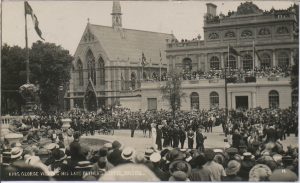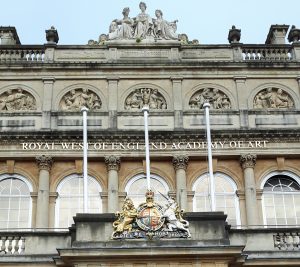
The photograph shows King George V visiting the statue of his father King Edward VII in front of the Victoria Rooms (built in honour of George V’s grandmother, Queen Victoria) and to officially open the newly refurbished RWA.
As well as the royal crest indicating that Bristol Academy of Fine Arts now received royal patronage, the façade has been altered and the steps on either side removed to allow the main entrance to be from the ground floor.
The 1913 architectural changes reflect the emerging early 20th century styles and contrast with the neo-classical features of the original Victorian building.
Of particular interest: It is interesting to consider the changes made to the building in honour of its becoming the Royal West of England Academy and what kind of image this new title was helping to promote, rather than the more parochial sounding Bristol Academy of Fine Arts. The building is surrounded by references to the royal family and it is interesting to consider the difference that royal patronage makes.
The royal coat of arms is the official coat of arms for the British monarch (George V was king at the time the RWA received its royal patronage in 1913). The motto, dieu at mon droit translated from the French as God and my (divine) right apparently dates back to Richard l (1157-1199) allegedly as a battle cry and thought to be a reference to what was believed to be his God-given (divine) right to reign. It was officially adopted as the royal motto of England by Henry V (1386-1422).
The royal crest is centrally positioned, the lion and unicorn in colours contrasting with the monochromatic façade of the RWA.
Debra Brown comments that throughout classical literature, “unicorns were described as large and very fierce. Thus they were chosen to guard the Royal Arms, and it explains why they are also chained up.” Visit http://englishhistoryauthors.blogspot.co.uk/2012/06/royal-coat-of-arms.html to learn more about the royal coat of arms and its significance.
